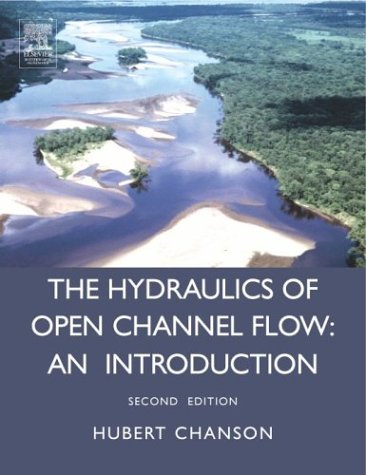 Introduction
to
Catchment Hydraulics and Open Channel Flow (CIVL3140)
Introduction
to
Catchment Hydraulics and Open Channel Flow (CIVL3140) Introduction
to
Catchment Hydraulics and Open Channel Flow (CIVL3140)
Introduction
to
Catchment Hydraulics and Open Channel Flow (CIVL3140)Catchment hydraulics. Behaviour of flows in channels; open channel flow; uniform equilibrium and gradually-varied flows; hydraulic modelling; culvert design.
Subject purpose: The aim of the subject is to develop a sound understanding of the fundamental fluid mechanics principles and their application to professional water engineering problems. Fundamental fluid mechanics principles are applied to professional water engineering problems. As a result of undertaking the subject, each student will comprehend the hydraulics of rivers and canals, and grasp the basic catchment processes.Subject rationale: The term 'Hydraulics' is related to the application of the Fluid Mechanics principles to water engineering structures, civil and environmental engineering facilities: e.g., canal, river, dam, reservoir, water treatment plant.In the subject, the students are introduced to the hydraulics of a catchment : rainfall, runoff and streamflow. The section "Introduction to Open channel flows" applies the basic principles of fluid mechanics to open channel flows. Examples of open channels are natural streams and rivers. Man-made channels include irrigation and navigation canals, drainage ditches, sewer and culvert pipes running partially full, and spillways. The lecture draws upon the students' expertise in catchment hydrology and water runoff gained in Hydrology Part of the subject. The teaching is focused on the application of the fundamental principles to open channel flow. The interactions between hydrology and hydraulics (e.g. rainfall and river discharge) are further discussed and the students are introduced to real-world engineering situations including failures. At the end of the subject, the design of a hydraulic system is introduced based on a system approach. The hydraulic structure must be analysed as part of the surrounding catchment and the hydrology plays an important role. Structural and hydraulic constraints interact, and the design of a hydraulic structure is a complex exercise altogether. First the system must be identified. What are the design objectives ? What are the constraints ? What is the range of options ? What is the "best choice" ? Its detailed analysis must be conducted and the engineers should ask : is this solution really satisfactory ? During design stages, physical and computational models may be reliable 'tools' to compare the performances of various design options.After completion of the subject, each student will know how to apply the fundamental fluid mechanics principles to professional designs and they will be familiar with the multi-disciplinary aspects of an engineering project.
Assumed background: The subject is a professional subject. It is expected that the students have mastered the fundamental principles of fluid mechanics (subject CIVL2131). The subject is the first of a series of two subjects (CIVL3140 and CIVL4120) dealing with river engineering, hydraulic structures and their interactions with the environment.
+ CHANSON, H. (2004). "The Hydraulics of Open Channel Flow : An Introduction." Butterworth-Heinemann, Oxford, UK, 2nd edition (ISBN 978 0 7506 5978 9).
Review : "This book will be useful for undergraduate students and I would recommend it to them. I also think that graduate students and practical engineers will benefit by studying this book. One cannot miss the tremendous enthusiasm the author has for hydraulic engineering." Professor N.RAJARATNAM, University of Alberta, in Canadian Journal of Civil Engineering, Volume 32, No. 1, 2005, p. 298. {Read Full Review}
+ CHANSON, H. (1999). "The Hydraulics of Open Channel Flow : An Introduction." Butterworth-Heinemann, Oxford, UK, 512 pages (ISBN 0 340 74067 1). {Support website : http://www.bh.com/companions/0340740671} Corrections & Updates [Newsletters No. 1, No. 2]
Spanish edition : "Hidraulica Del Flujo en Canales Abiertos", McGraw Hill Interamericana, División Universidad, Columbia (ISBN: 958-410-256-7).
Chinese edition : Hydrology Bureau of Yellow River Conservancy Committee, March 2003 (ISBN 7-80621-529-8).
Review : "Without a doubt, this is the best introduction to the hydraulics of open channel flow that I have yet to read." Professor S.N. LANE, University of Leeds, Environmental Conservation, Volume 27 2000, Issue 3, pp 314-315. {Read Full Review}+ Technical references (Open access)
APELT, C.J. (1983). Hydraulics of Minimum Energy Culverts and Bridge Waterways, Australian Civil Engrg Trans., I.E.Aust., Vol. CE25, No. 2, pp. 89-95. (PDF file at UQeSpace) (Download PDF file)
CHANSON, H. (2000). Introducing Originality and Innovation in Engineering Teaching: the Hydraulic Design of Culverts, European Journal of Engineering Education, Vol. 25, No. 4, pp. 377-391. (PDF file at UQespace)
CHANSON, H. (2006). "Minimum Specific Energy and Critical Flow Conditions in Open Channels." Journal of Irrigation and Drainage Engineering., ASCE, Vol. 132, No. 5, pp. 498-502 (doi:10.1061/(ASCE)0733-9437(2006)132:5(498)) (ISSN 0733-9437). (PDF file) (PDF file at UQeSpace). Closure: Journal of Irrigation and Drainage Engineering, ASCE, Vol. 134, No. 6, pp. 883-887 (DOI: 10.1061/(ASCE)0733-9437(2008)134:6(883)) (ISSN 0733-9437). (PDF file at UQeSpace).
CHANSON, H. (2007). "Hydraulic Performances of Minimum Energy Loss Culverts in Australia." Journal of Performances of Constructed Facilities, ASCE, Vol. 21, No. 4, pp. 264-272 (ISSN 0887-3828). (PDF file at UQeSpace)
CHANSON, H. (2012). "Momentum Considerations in Hydraulic Jumps and Bores." Journal of Irrigation and Drainage Engineering, ASCE, Vol. 138, No. 4, pp. 382-385 (DOI 10.1061/(ASCE)IR.1943-4774.0000409) (ISSN 0733-9437). (Postprint at UQeSpace) (PDF file)
TOOMBES, L., and CHANSON, H. (2011). "Numerical Limitations of Hydraulic Models." Proc. 34th IAHR World Congress, Brisbane, Australia, 26 June-1 July, Engineers Australia Publication, Eric VALENTINE, Colin APELT, James BALL, Hubert CHANSON, Ron COX, Rob ETTEMA, George KUCZERA, Martin LAMBERT, Bruce MELVILLE and Jane SARGISON Editors, pp. 2322-2328 (ISBN 978-0-85825-868-6). (PDF file) (Record at UQeSpace)
+ Advanced Hydraulic Engineering and Design, CIVL4120 website
+ Environmental Modelling, CIVL4140 website
+ Softwares : HydroChan & HydroCulv by Hydrotools software (For teaching purposes only)
+ 2010-2011 Queensland floods - Bibliography
The 2010-2011 Floods in Queensland (Australia): Observations, First Comments and Personal Experience, in Journal La Houille Blanche, No. 1, pp. 5-11 (ISSN 0018-6368). (PDF file) (Record at UQeSpace)
Queensland Flood Observations, in Water Engineering Australia, Vol. 5, No. 2, April, pp. 22-23 (ISSN 1835-1123). (PDF file) (Record at UQeSpace)
The 2010-2011 Floods in Queensland (Australia): Photographic Observations, Comments and Personal Experience, Hydraulic Model Report No. CH82/11, School of Civil Engineering, The University of Queensland, Brisbane, Australia, 127 pages (ISBN 9781742720234)..
Turbulent Velocity and Suspended Sediment Concentration Measurements in an Urban Environment of the Brisbane River Flood Plain at Gardens Point on 12-13 January 2011. Hydraulic Model Report No. CH83/11, School of Civil Engineering, The University of Queensland, Brisbane, Australia, 120 pages (ISBN 9781742720272). (PDF file at UQeSpace) (PDF file low-resolution)
+ Many articles in hydraulic engineering may be freely downloaded from UQeSpace: {http://espace.library.uq.edu.au/list.php?browse=author&author_id=193}. All the articles are listed in the OAIster catalog system {http://www.oclc.org/search/}.
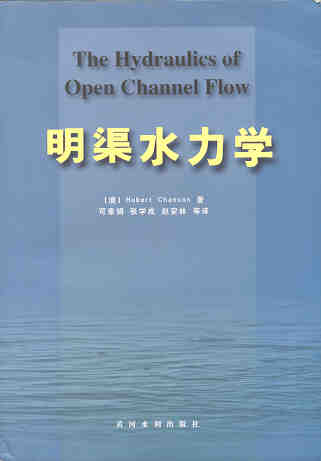
3. Froude Number
The Froude number is proportional to the square root of
the ratio of the inertial forces over the weight of fluid. The Froude
number is used generally for scaling free surface flows, open channels and
hydraulic structures. Although the dimensionless number was named after
William FROUDE, several French researchers used it before. BELANGER
(1841), DUPUIT (1848) and BRESSE (1860) highlighted the significance of
the number to differentiate the open channel flow regimes. BAZIN (1865a)
confirmed experimentally the findings. Ferdinand REECH introduced the
dimensionless number for testing ships and propellers in 1852. The number
is called the Reech-Froude number in France (CHANSON
1999, pp. 39-46).
In rectangular channels, the Froude number is commonly
defined as the ratio of the flow velocity to the square root of the
product of g times d, where d is the flow depth and g is the gravity
acceleration.
4. Properties of Common Open-Channel Shapes
In practice, natural and man-made channels do not have
often a rectangular cross-section. Critical flow conditions are defined as
the flow conditions for which the mean specific energy is minimum (CHANSON
1999, pp. 46-48). In a horizontal channel and assuming hydrostatic
pressure distribution, critical flow conditions imply :
Applications of the Momentum Principle : Hydraulic Jump, Surge, Flow
Resistance in Open Channels
2. Hydraulic jump
A hydraulic jump is a stationary transition from a
rapid (supercritical flow) to a slow flow motion (subcritical flow).
Although the hydraulic jump was described by LEONARDO DA VINCI, the first
experimental investigations were published by Giorgio BIDONE in 1819 and
the first theoretical analysis was conducted by BELANGER (1841). It is
extremely turbulent and characterised by the development of large-scale
turbulence, surface waves and spray, energy dissipation and air
entrainment (eg CHANSON
and
BRATTBERG 2000). The large-scale turbulence region is usually called
the 'roller'. Experimental observations highlight different types of
hydraulic jumps, depending upon the Froude number of the upstream flow. An
undular hydraulic jump is observed at low Froude numbers (1< Fr <3):
looking downstream (Fr=1.2) and sideview (Fr=1.6). With increasing Froude numbers,
other types of jumps include weak jump, oscillating jump (3.5< Fr
<4.5), steady jump and strong
jump (Fr >10).
These photographs show surfers riding on a hydraulic
jump roller in a river in Munich, Germany (Photo
No. 1 : flow from right to left, Photo
No. 2: looking downstream, Courtesy of Dale YOUNG).
Advanced lecture material: "Momentum Considerations in Hydraulic Jumps and Bores." Journal of Irrigation and Drainage Engineering, ASCE, Vol. 138, No. 4, pp. 382-385 (DOI 10.1061/(ASCE)IR.1943-4774.0000409) (ISSN 0733-9437). (Postprint at UQeSpace) (PDF file)
3. Surges and Tidal Bores
A surge in an open channel is a sudden change of flow
depth (i.e. abrupt increase or decrease in depth). An abrupt increase in
flow depth is called a positive surge while a sudden decrease in depth is
termed a negative surge. This picture shows an undular
surge (propagation from left to right).
A positive surge looks like a moving hydraulic jump.
The application of the momentum principle to the unsteady flow is based
upon a quasi-steady flow situation analogy (CHANSON
1999, pp. 67-71).
A bore is a positive surge of tidal origin. Tidal bores
occur as the tidal flow turns to rising (e.g. Lynch
1982) (Links : (1)
). Famous ones include the Hangchow (or Hangzhou) bore on the Qiantang
river (photo: (1),
(2) , (3)
), the Amazon bore called pororoca (photo: (1),
(2)
, (3) ;
info: see below ), the tidal bore on the Seine river (mascaret)
(photo: (1) ;
info: (2) ), the Hoogly (or Hooghly) bore on
the Gange, the bore on the Mekong river. Smaller tidal bores occur on the
Severn river near Gloucester, England (photo : (1),
(2)
, (3) ), on the
Trent river (aegir) (photo: (1)),
on the Garonne and Dordogne rivers, France (photo: (1),
(2)
, (3); info: (3)
(4) ), at Turnagain Arm and
Knik Arm, Cook Inlet (Alaska) (info: (1)
; photo: (2) , (3)
), the bores in the Bay of Fundy (New Brunswick, Nova Scotia) like at
Petitcodiac (info: (1)
), tidal bores on the Styx river QLD and on the Daly river NT (Australia),
the tidal bore called benak at Batang Lupar (Malaysia) (photo (1)).
The front of a positive surge absorbs random
disturbances on both sides of the surge and this makes the positive surge
stable and self-perpetuating. With appropriate boundary conditions, a
tidal bore may travel long distances upsteam of the river mouth. For
example, the tidal bore on the Pungue river (Mozambique) is still about
0.7 m high about 50 km upstream of the mouth and it may reach 80 km
inland.
Hubert Chanson observed the tidal bore of the Dordogne
river on 27 Sept. 2000 (5:00pm). The bore propagates first in the Gironde
before separating and continuing both in the Garonne and in the Dordogne (Map).
At
St Pardon, the tidal bore was an undular bore on the 27 Sept. 2000.
Photographs No. 1 and 3 illustrate the undular nature of the positive
surge. Photo No. 1 shows the arriving
bore. Photo No. 2 illustrates kayacks
and surfers riding the bore. Photo No. 3
was taken just downstream of St Pardon while Photo
No. 4 was shot in front of St Pardon.
References :
CHANSON, H. (2001). "Flow Field in a Tidal Bore : a Physical Model." Proc. 29th IAHR Congress, Beijing, China, Theme E, Tsinghua University Press, Beijing, G. LI Ed., pp. 365-373 (ISBN 7-302-04676-X/TV). (CD-ROM, Tsinghua University Press, ISBN 7-900637-10-9.) (download PDF file)
DONNELLY, C., and CHANSON, H. (2002). "Environmental impact of a Tidal Bore on Tropical Rivers." Proc. 5th Intl River Management Symp., Brisbane, Australia, Sept., 3-6, 9 pages. (Download PDF File)
CHANSON, H. (2011). "Current Knowledge in Tidal bores and their Environmental, Ecological and Cultural Impacts." Environmental Fluid Mechanics, Vol. 11, No. 1, pp. 77-98 (DOI: 10.1007/s10652-009-9160-5) (ISSN 1567-7419 [Print] 1573-1510 [Online]). (PDF file) (Record at UQeSpace)
CHANSON, H. (2011). "Tidal Bores, Aegir, Eagre, Mascaret, Pororoca: Theory and Observations." World Scientific, Singapore, 220 pages (ISBN 9789814335416). (Table of Contents at UQeSpace)
4. Flow resistance in open channel flows
In open channel flows, flow resistance can be neglected
over a short transition as a first approximation, and the continuity
and Bernoulli equations can be applied to estimate the downstream flow
properties as functions of the upstream flow conditions and boundary
conditions. But the approximation of frictionless flow is no longer valid
for long channels. Considering a water supply canal extending over several
kilometres, the bottom and sidewall friction retards the fluid, and, at
equilibrium, the friction force counterbalances exactly the weight force
component in the flow direction.
The laws of flow resistance in open channels are
essentially the same as those in closed pipes. In an open channel, the
calculations of the boundary shear stress are complicated
by the existence of the free surface and the wide variety of possible
cross-sectional shapes. The boundary shear stress equals :
to =
f/8 r V2
where f is the Darcy-Weisbach friction factor and V is the mean flow
velocity (HENDERSON 1966, CHANSON 1999).
As
for pipe flows, the flow regime in open channels can be either laminar or
turbulent. In industrial applications, it is commonly accepted that the
flow becomes turbulent for Reynolds numbers larger than 2000 to 3000, the
Reynolds number being defined for pipe and open channel flows as Re = V*DH/n where DH is the hydraulic diameter or
equivalent pipe diameter. The Darcy friction
factor f may be calculated as a function of the relative roughness ks/DH
and Reynolds number from the Moody diagram
In open channels, the Darcy-Weisbach friction equation
(see above) is valid using the hydraulic diameter as equivalent pipe
diameter. It is the only sound method to estimate the energy loss. For
various reasons (mainly historical reasons), empirical resistance
coefficients (e.g. Chézy coefficient) were and are still used. The Chézy
coefficient was introduced in 1768 while the Gauckler-Manning coefficient
was first presented in 1865 : i.e., well before the classical pipe flow
resistance experiments in the 1930s. Historically both the Chézy and the
Gauckler-Manning coefficients were expected to be constant and functions
of the roughness only. But it is now well recognised that these
coefficients are only constant for a range of flow rates. Most friction
coefficients (except perhaps the Darcy friction factor) are estimated
100%-empirically and they apply only to fully-rough turbulent water flows
(CHANSON 1999). In practice, only the
Darcy-Weisbach friction factor must be used for man-made channels.
Note : The Gauckler-Manning equation is often called improperly the Manning equation. In fact it was first proposed by the Frenchman P.G. GAUCKLER in 1867 (GAUCKLER 1867) based upon the re-analysis of experimental data obtained by H.P.G. DARCY and H. BAZIN (DARCY and BAZIN 1865). Robert MANNING (1816-1897), chief-engineer at the Office of Public Works, Ireland, presented two flow resitance formula in 1890. One was the 'Gauckler-Manning' formula but Robert MANNING did prefer to use his second formula.
Culvert design
A culvert is a covered channel of relatively short length designed to pass
water through an embankment (e.g. highway, railroad, dam). It is a
hydraulic structure and it may carry flood waters, drainage flows, natural
streams below earthfill and rockfill structures. From a hydraulic aspect,
a dominant feature of a culvert is whether it runs full or not.
The design can vary from a simple geometry (i.e. box
culvert) to a hydraulically-smooth shape (i.e. MEL
culvert, photo No. 1 & photo No. 2). The lectures review first
the design of standard culverts, then the design
of minimum energy loss culverts.
Box culvert calculations
Hydraulic calculations of upstream head above invert bed for box culverts
with Inlet Control (Concrete Pipe Association of Australia 1991) (DOUBLE-CLICK for full size .WMF
file)
Hydraulic calculations of total head losses for concrete box culverts
flowing full (i.e. drowned) (Concrete Pipe Association of Australia
1991) (DOUBLE-CLICK for full
size .TIF file)
Alternative : .PDF file
(both charts)
Minimum Energy Loss culvert design
A Minimum Energy Loss (MEL) culvert is the open channel flow analogy of
the Venturi.
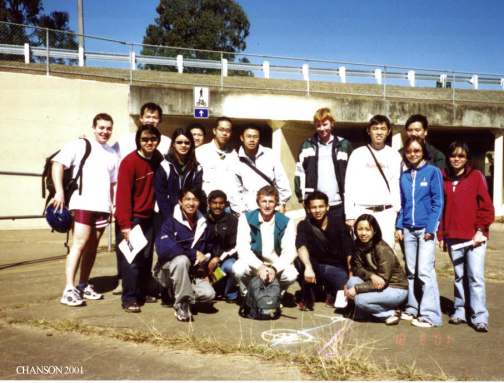 MEL culvert outlet. Field trip in Aug. 2001 with CIVL3120 class
MEL culvert outlet. Field trip in Aug. 2001 with CIVL3120 class Video movies on YouTube
How to work on engineering problems - An approach to tutorials, examinations, applications, and case studies (version 29/1/2017)
2017 Tutorials
Tutorial No. 1 :Fluid properties and basic equations. Bernoulli principle
Tutorial No. 2 : Continuity,Momentum and Bernoulli principles
Tutorial No. 3 : Uniform equilibrium and non-uniform open channel flows
Tutorial No. 4 : Physical modelling
Tutorial No. 5 : Hydraulic design of culverts
2016 Tutorials
Tutorial No. 1 : Fluid properties and basic equations. Bernoulli principle (version 21/12/2015)
Tutorial No. 2 : Continuity, Momentum and Bernoulli principles (version 21/12/2015)
Tutorial No. 3 : Uniform equilibrium and non-uniform open channel flows (version 21/12/2015)
Tutorial No. 4 : Physical modelling (version 10/6/2016)
Tutorial No. 5 : Hydraulic design of culverts (version 19/5/2016)
2011 Tutorials (1)
Tutorial No. 1 : Fluid properties and basic equations. Bernoulli principle (version 24/07/2011)
Tutorial No. 2 : Continuity, Momentum and Bernoulli principles (version 04/10/2011)
Tutorial No. 3 : Uniform equilibrium and non-uniform open channel flows (version 24/07/2011)
Mid-semester quizz results
Download softwares : HydroChan & HydroCulv by Hydrotools software (For teaching purposes only)
2009 Tutorials
Tutorial No. 1 : Fluid properties and basic equations. Bernoulli principle (version 30/07/2009)
Tutorial No. 2 : Continuity, Momentum and Bernoulli principles (version 8/09/2009)
Positive surge application (version 2/09/09)
Flow resistance calculations in open channel flows and flood plain application (version 7/09/09)
Tutorial No. 3 : Uniform equilibrium and non-uniform open channel flows (version 3/09/2009)
Backwater Lecture spreadsheet (version 19/09/2007)
Tutorial No. 4 : Physical modelling (version 11/09/2009)
Tutorial No. 5 : Hydraulic design of culverts (by Dr D. Callaghan)
Download softwares : HydroChan & HydroCulv by Hydrotools software (For teaching purposes only)
Mid-semester quizz results (9 Sept. 2009)
2007 Tutorials
Tutorial No. 1 : Fluid properties and basic equations. Bernoulli principle (version 24/07/2007)
Tutorial No. 2 : Continuity, Momentum and Bernoulli principles (version 26/08/2007)
Tutorial No. 3 : Flood plain and backwater calculations (version 5/09/2007, checked on 2/10/2007)
Backwater Lecture spreadsheet (version 19/09/2007)
Tutorial No. 4 : Hydraulic Design of Culverts (version 23/10/2007)
MEL culvert worked example No. 1 (18/09/2007)
Tutorial No. 5 : Physical modelling in hydraulic engineering (version 10/10/2007)
Download softwares : HydroChan & HydroCulv by Hydrotools software (For teaching purposes only)
Open channel hydraulics - Text book exercises with solutions
http://www.bh.com/companions/0340740671/exercises/ (or http://www.bh.com/companions/0340740671/exercises/exercisesP1.htm).
2003 Tutorials
Tutorial on culvert design : version 12 Sept. 2003.
Tutorial on physical modelling : version 12 Sept. 2003.
Download softwares : HydroChan & HydroCulv by Hydrotools software (For teaching purposes only)
2002 Tutorials
Tutorial No. 1 : Fluid properties and basic equations. Bernoulli principle (1) (version 17/8/02).
Tutorial No. 4 : Flood plain and backwater calculations (version 1/9/02)
Tutorial No. 5 : Physical modelling. (version 26/8/02)
Tutorial No. 6 : Culvert design. (version 27/8/02)
Revision assignment : Hydraulics of the Nimes aqueduct (version 14/10/02) [1 Mb]
Open channel hydraulics - Text book exercises with solutions
http://www.bh.com/companions/0340740671/exercises/ (or http://www.bh.com/companions/0340740671/exercises/exercisesP1.htm).
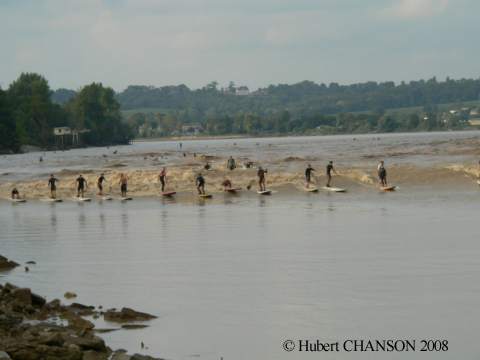 Tidal
bore
of the Dordogne River on 2 Sept. 2008
Tidal
bore
of the Dordogne River on 2 Sept. 2008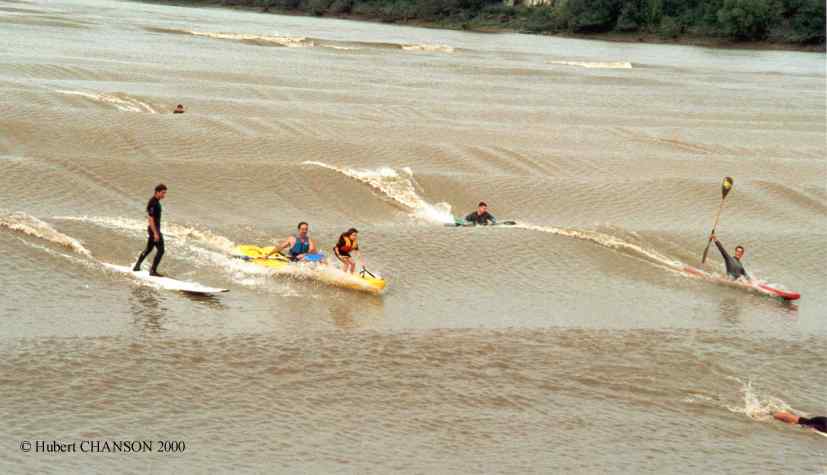 Tidal bore on the Dordogne River (27/9/2000)
Tidal bore on the Dordogne River (27/9/2000)Open channel hydraulicsGeneral information - Experiment description - Time schedule (see Blackboard)Video movies of the experiments
Laboratory work is closely linked with the lecture program and it is an integral part of the hydraulics course. Four experiments are conducted during the semester.
Two experiments are linked to basic open channel flows: a study of a broad-crested weir overflow (photo) and the hydraulic jump (photo No. 1, photo No. 2). The former (broad-crested weir) is a smooth transition from an upstream sub-critical flow to a downstream supercritical flow. The latter (hydraulic jump) is the transition from an upstream supercritical flow to a downstream subcritical flow.
The students conduct two further experiments on culvert design (photo) and backwater effects in a long channel (photo No.1, photo No. 2). The main purpose of the frmer experiment is to understand the differences between the hydraulic performances of two different types of culverts carrying the same flow rate (photo No. 1, photo No. 2). (Read about the minimum energy loss culvert.). The purpose of the long channel experiment is to demonstrate open channel control features, and to quantify friction and backwater effects in waterways. In each case, the experimental procedure includes observations, prediction (numerical modelling) and evaluation (comparison between data and computations).
Description of CIVL3140 laboratory experiments (incl. HUPP Laboratory Safety declaration) - See Blackboard
CHANSON, H. (2020). "Hydraulics of open channel flow: practical experiments at the University of Queensland, Australia." Collection, Generic Document, The University of Queensland, School of Civil Engineering, Brisbane, Australia (ISBN 978-1-74272-311-2).
{https://espace.library.uq.edu.au/collection/UQ:734960}
"The Broad-Crested Weir." Generic Document, The University of Queensland, School of Civil Engineering, Brisbane, Australia, 2020 (ISBN 978-1-74272-311-2). {https://espace.library.uq.edu.au/view/UQ:734961}
"The Hydraulic Jump." Generic Document, The University of Queensland, School of Civil Engineering, Brisbane, Australia, 2020 (ISBN 978-1-74272-311-2). {https://espace.library.uq.edu.au/view/UQ:734962}
"Backwater in a Long Channel." Generic Document, The University of Queensland, School of Civil Engineering, Brisbane, Australia, 2020 (ISBN 978-1-74272-311-2). {https://espace.library.uq.edu.au/view/UQ:734963}
"Hydraulics of Culverts." Generic Document, The University of Queensland, School of Civil Engineering, Brisbane, Australia, 2020 (ISBN 978-1-74272-311-2). {https://espace.library.uq.edu.au/view/UQ:734964}
Field trip on Tues. 19 April 2016 (Start 07:45am)
Presentation, instructions and outline on Blackboard.
Read on the Minimum Energy Loss culverts & Gold Creek dam stepped spillway
Photographs
Photo No. 1: Students working on the steps of Gold Creek dam spillway on 19 April 2016.
Photo No. 2: CIVL3140 students on the spillway crest on 19 April 2016.
Photo No. 3: Gold Creek dam stepped chute on 19 April 2016.
Photo No. 4: CIVL3140 students in a MEL culvert barrel on 19 April 2016.
Photo No. 5: MEL culvert outlet on 19 April 2016.
Field trip on Wed. 9 Sept. 2009 (Start 11:00am)
Presentation: Read instructions and outline (version 7 Sept. 2009)
Read on the Minimum Energy Loss culverts & Gold Creek dam stepped spillway
Student feedback
Read the CIVL3140 students' feedback on the 2009 field trip (anonymous survey responses).
Photographs
Standard culvert along Sandy Creek: CIVL3140 students in the field trip on 9 Sept. 2009: Photo No. 1 and Photo No. 2 (Courtesy of Stefan FELDER).
MEL culvert benath the SE freeway embankment during the CIVL3140 student field trip on 9 Sept. 2009: Inlet of the MEL culvert, looking upstream; Outlet of of the MEl culvert.
MEL waterway beside Lewisham Street and under the SE freeway during the CIVL3140 student field trip on 9 Sept. 2009: student group in front of the inlet.
MEL culvert beneath Ridge Street: students walking in the outlet with the low-flow drain in the foreground.
Gold Creek dam spillway during the CIVL3140 student field trip on 9 Sept. 2009: students studying the first two steps; Students on the lower steps of the staircase spillway; Students inspecting the broad-crest (Courtesy of Stefan FELDER).
Field trip on Wed. 5 Sept. 2007 (Start 11:00am)
Storm waterway systems & Gold Creek dam spillway : Read instructions and outline (version 26 Aug. 2007)
Read on the Minimum Energy Loss culverts & Gold Creek dam stepped spillway
Photographs
MEL culvert beneath Ridge street : Outlet during CIVL3140 field trip on 5 Sept. 2007 : Photo 1 & Photo 2.
Gold Creek dam spillway during CIVL3140 field trip on 5 Sept. 2007 : Photo 1 & Photo 2.
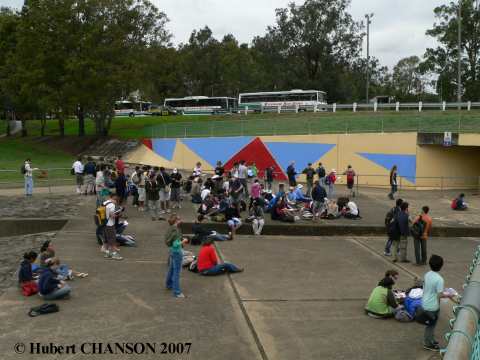

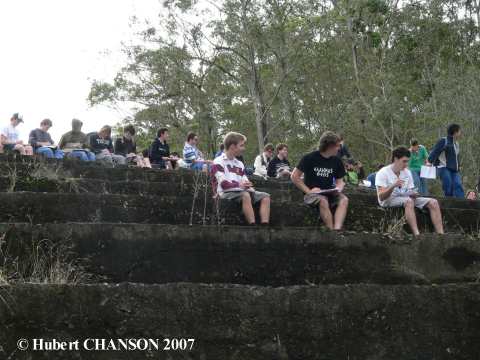
Field trip on Thu. 18 Sept. 2003
Storm waterway system in Helenvale, incl. culverts and dissipators & Minimum Energy Loss culverts and flood plains along Norman Creek beneath the South-East freeway. Instructions and outline (version 10 Sept. 2003)
Read on the Minimum Energy Loss culverts
Photographs
Ekibin park MEL culvert : Inlet during CIVL3140 field trip on 18-09-2003.
Ridge St MEL culvert outlet during CIVL3140 field trip on 18-09-2003: Photo No.1, Photo No. 2, Photo No. 3.
Student relaxation !
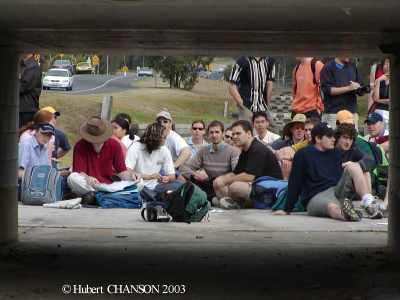
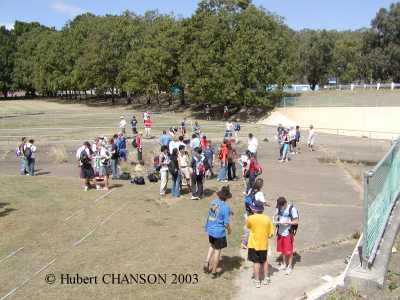
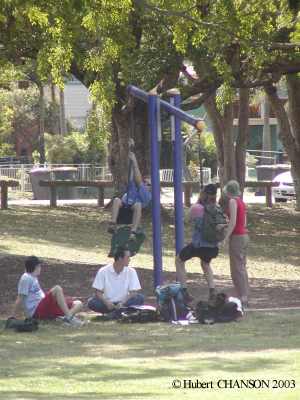
Field trip on Wed. 11 Sept. 2002
Minimum Energy Loss culverts beneath the Gateway motorway and Gold Creek dam spillway : Instructions and outline. (version 13 Aug. 2002)
Read on the Minimum Energy Loss culverts and History of the Gold Creek dam spillway.Photographs
MEL culvert No. MEL-C-4 (CHANSON 1999). Design discharge : ~220 m3/s. MEL culvert beneath the Gateway motorway (Brisbane, Australia). Photo No. 1a : inlet on 11 Sept. 2002 during CIVL3140 student field trip. Photo No. 1b : inlet wingwall on 11 Sept. 2002 during CIVL3140 student field trip.
MEL culvert No. MEL-C-5 (CHANSON 1999). Design discharge : ~100 m3/s. MEL culvert beneath the Gateway motorway (Brisbane, Australia). Photo No. 2a : inlet on 11 Sept. 2002 during CIVL3140 student field trip. Photo No. 2b : students in inlet channel on 11 Sept. 2002 during CIVL3140 student field trip. Photo No. 2c : students at the dowsntream end of the barrel on 11 Sept. 2002 during CIVL3140 student field trip.
Gold Creek dam spillway on 11 Sept. 2002 : Photo 3a and Photo 3b/
/
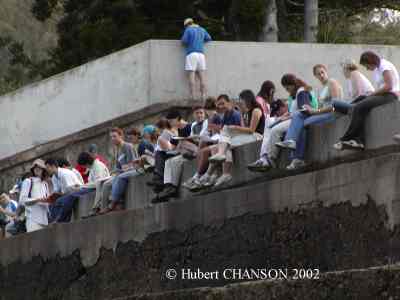
Photographs
Field trip to minimum energy loss waterway (Aug. 2000), (Aug. 2001), (May 2002).
Field trip to Gold Creek dam (Aug. 2000).. Read on the History of the Gold Creek dam spillway.
Rating : [***] = superb, must see - [**] = excellent
Rivers Seen from Space [**]
EPA Multimedia projects (USA) (computations, remote sensing)
Structurae, International Database and Gallery of Structures [**]
Gallery of Photographs in Fluid Mechanics, Hydraulic & Environmental Engineering and Engineering History
Internet resources in Hydraulic & Environmental Engineering
Aerial photographs of American rivers and valleys [**]
NASA Earth observatory [***]
NASA Visible Earth [***]The Formal Water Garden
Unesco World Heritage Listing (for Virtual Tours, click here [**])Unesco Photobank [**]
Gallery of photographs in fluid dynamics by Mark Kramer [**]
SoftwaresHydrochan (TM) [**] Gradually-varied flows (1D) (for teaching purposes ONLY)
US Army Corps of Engineers HEC Softwares
LacusCurtius - Roman Waterworks and Hydraulic Engineering [***]
Roman Aqueducts and Water Systems (Rome aqueduct system)
Ostia - Harbour of Ancient Rome (Italy)
Gorze Aqueduct at Metz (France) [**]
The Aqueduct in Caesarea (Israel)
Aqueduc de Cahors (in French)Hydraulics of Roman Aqueducts : Steep Chutes, Cascades and Dropshafts, AJA, 2000
National Weather Service Office of Hydrology
El Niño Information in California
Extreme reservoir siltation in Australia
River of the World [Map] [**]
The tidal bore of the Seine river
Artifical river habitats and fish passes (photographs)
Flood plains (photographs)
Photographs of River Floods in Australia [**] (Search for : floods)
Aerial photographs of American rivers and valleys [**]
Chicago Calumet waterway: sidestream aeration cascades
Petit-saut dam (French Guyana): aeration cascade
Petit-Saut dam : photographs, dam details
Bureau of Meteorology
Goulburn-Murray Water
Hydro-Electric Corporation (Tasmania)
Murray-Darling Basin Commission
NSW Department of Land and Water Conservation
QLD Department of Natural Resources [Water, Storages] [Glossary of terms]
Mount St. Helens (USA), debris and mud flows, Photofile [**]
California 1997 Flood Images
Chicago Calumet waterway: sidestream aeration cascades
Petit-saut dam (French Guyana)
US Army Corps of Engineers, Walla Walla district [Photographs are listed Here]
US Army Corps of Engineers, Portland district, Photofile [**]History of arch dams
The Rideau Canal (Canada) incl. the 1831 Jones Falls arch dam [*]
Steel damsTimber Crib Weirs in Queensland, Australia
Air entrainment on chutes spillways
Rubber dams
Minimum Energy Loss (MEL) culverts and bridge waterways
Embankment overflow stepped spillways: earth dam spillways with precast concrete blocks
Spillway Aeration Devices to prevent Cavitation Damage in high-head chutes {http://www.uq.edu.au/~e2hchans/aer_dev.html}
ICOLD (International Commission on Large Dams)
Dams Safety Committee of New South Wales Australia
British Dam SocietyBureau of Reclamation Dams DataWeb
US Army Corps of Engineers Reservoirs in Pittsburgh's district
US Army Corps of Engineers, Walla Walla district [Photographs are listed Here]
US Army Corps of Engineers, Portland district, Photofile [**]
Gabion hydraulic structures (small dams, weirs) [Maccaferri]
Steel dams
Timber Crib Weirs in Queensland, Australia
History of arch dams
Rubber dams
The Minimum Energy Loss (MEL) weir design
Overflow embankment stepped spillwaysItaipu dam (Brazil/Paraguay)
Petit-saut dam (French Guyana)Spillway design and operation
California 1997 Flood Images
Air entrainment on chutes spillways
Spillway Aeration Devices to prevent Cavitation Damage in high-head chutesStepped spillwaysWorld's oldest stepped spillway (Greece)
Santa Cruz dam stepped spillway (USA)
Greeley spillway (USA) [*]
Stepped spillway photographs
Embankment overflow stepped spillways: earth dam spillways with precast concrete blocks
Hydraulics of Minimum Energy Loss (MEL) culverts and bridge waterways
Introducing Originality and Innovation in Engineering Teaching: the Hydraulic Design of Culverts, European Journal of Engineering Education, Vol. 25, No. 4, pp. 377-391.
Hydraulics of Minimum Energy Culverts and Bridge Waterways, Australian Civil Engrg Trans., I.E.Aust., Vol. CE25, No. 2, pp. 89-95.
SoftwaresHydroculv (TM) [***] Culvert hydraulics (Complete download including VB support files : http://www.compusmart.ab.ca/dwilliam/download.htm) (for teaching purposes ONLY)
Hydrochan (TM) [**] Gradually-varied flows (1-D) (for teaching purposes ONLY)
French Naval and Hydrographic Service SHOM [**]
Tidal bore (mascaret) of the Seine river
Photographs of tidal bores (incl. mascaret, pororoca)
WhirlpoolsTide calculations worldwide (in French)
Coastal engineering web page of Dr Robert A. Dalrymple
Tsunami : Information - PhotographsInlets on-line (USACE) [**]
CHANSON, H. (2008). "Some Experience with Digitial Publishing, Open Access Repository, Research Impact and Quality." Proc.Open Access Collection workshop, Australian Partnership for Sustainable Repositories, Brisbane, 14 Feb., 12 pages. (PDF file at UQeSpace)
CHANSON, H. (2007). "Research Quality, Publications and Impact in Civil Engineering into the 21st Century. Publish or Perish, Commercial versus Open Access, Internet versus Libraries ?" Canadian Journal of Civil Engineering, NRC, Vol. 34, No. 8, pp. 946-951 (DOI:10.1169/L07-027) (ISSN 0315-1468). (PDF file at UQeSpace) (Preprint at UQeSpace)
CHANSON, H. (2007). "Impact of Commercial Search Engines and International Databases on Engineering Teaching and Research." European Journal of Engineering Education, SEFI, Vol. 32, No. 3, pp. 261-269 (doi: 10.1080/030437901423815) (ISSN 0304-3797 print / ISSN 1469-5898 online). (PDF file at UQeSpace)
BALDOCK, T.E., and CHANSON, H. (2006). "Undergraduate Teaching of Ideal and Real Fluid Flows: the Value of Real-World Experimental Projects." European Journal of Engineering Education, Vol. 31, No. 6, pp. 729-739 (DOI: 10.1080/03043790600911837) (ISSN 0304-3797). (PDF file at UQeSpace) (PDF file at EprintsUQ)
CHANSON, H. (2005). "Commercial Search Engines, International Databases or Traditional Libraries ?" Jl of Hyd. Res., IAHR, Vol. 43, No. 6, Supplement, pp. A85-87 (ISSN 0022-1686). (also IAHR Newsletter, Vol. 22, No. 6, pp. 85-87.) (PDF Version at EprintsUQ)
CHANSON, H. (2005). "Should Field Works Be Compulsory in Hydraulic Engineering Courses ?" IAHR Newsletter, Vol. 22, No. 2, pp. 27-30. (Download PDF File)
CHANSON, H. (2004). "Enhancing Students' Motivation in the Undergraduate Teaching of Hydraulic Engineering: the Role of Field Works" Journal of Professional Issues in Engineering Education and Practice, ASCE, Vol. 130, No. 4, pp. 259-268 (ISSN 0733-9380). (Download PDF file)
CHANSON, H. (2002). "Paper vs Electronic !?!." IAHR Newsletter, Vol. 40, No. 3, p. 46. (Download PDF file)
CHANSON, H. (2001). "Teaching Hydraulic Design in an Australian Undergraduate Civil Engineering Curriculum." Jl of Hyd. Engrg., ASCE, Vol. 127, No. 12, pp. 1002-1008 (ISSN 0733-9429). (Download PDF File)
CHANSON, H. (2000). "Introducing Originality and Innovation in Engineering Teaching: the Hydraulic Design of Culverts." European Journal of Engineering Education, Vol. 25, No. 4, pp. 377-391 (ISSN 0304-3797). (Download PDF File)
CHANSON, H., and JAMES, P. (1998). "Teaching Case Studies in Reservoir Siltation and Catchment Erosion." Intl Jl of Engineering Education, Vol.14, No. 4, pp. 265-275 (ISSN 0949-149X). (Download PDF file) (Alternative PDF file)
University of Queensland LibraryMeasurement systems : SI Units and significant figures
Reprints of Research Papers in Water enginering
ICEnet: The Institution of Civil Engineers Homepage
Japan Society of Civil Engineers
ASCE - American Society of Civil Engineers Homepage
ASME Meetings & Exhibits Frames IndexENPC
Welcome to the IAHR homepageUS Geological Survey
Civil Engineering Resources on the Internet (GuideMe.com)Highlights in the History of Hydraulics by Hunter ROUSE
|
|
|
|
Back to TOP
Back to Prof
Chanson's Home Page